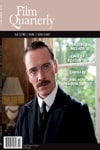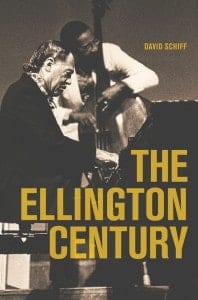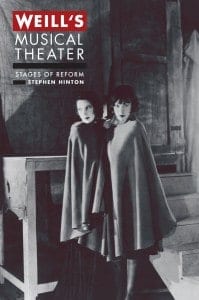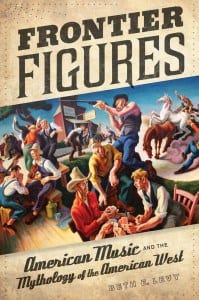 In the newest Acquiring Eye feature, Humanities Publisher Mary Francis gives us her take on the music and cinema titles and journals coming out this spring.
In the newest Acquiring Eye feature, Humanities Publisher Mary Francis gives us her take on the music and cinema titles and journals coming out this spring.
Starting with one of the flagship publications from our  Journals Division, Film Quarterly is always a treat to find in the mailbox. Never an issue goes by when I don’t learn something new (even after years of working in cinema and media studies), or discover a terrific new writer, or am compelled to go find a local screening of one of the films discussed–or all of the above!
Journals Division, Film Quarterly is always a treat to find in the mailbox. Never an issue goes by when I don’t learn something new (even after years of working in cinema and media studies), or discover a terrific new writer, or am compelled to go find a local screening of one of the films discussed–or all of the above!
What could be better? Film Quarterly online, of course. Editor Rob White supplements FQs regular feast of articles, columns, and reviews with a range of in-depth web exclusives, including more reviews of films, dialogs between writers and filmmakers, festival reports, and much more. My favorites are the dialogs around recent films and TV shows. White and Nina Powers on Lars von Trier’s “Melancholia” (a kind of continuation of their thoughtful response to von Trier’s controversial “Antichrist”) challenged me to revisit a film that confounded me on first viewing. And the excellent discussion of Todd Haynes’s version of “Mildred Pierce” was a treat for fans of both Haynes’s interpretation and the classic 1945 version.
 Ellington Century by David Schiff — Was Duke Ellington the greatest composer of the twentieth century? It would be easy to say that he was the greatest jazz composer. But David Schiff’s new book challenges readers to break down the false barriers between jazz, classical, and pop music to appreciate Ellington’s amazing music in the broadest possible context. Schiff’s elegant, evocative prose opens our ears to the way that Ellington’s music is as vital to musical modernism as anything by Stravinsky, more influential than anything by Schoenberg, and has had a lasting impact on jazz and pop that reaches from Gershwin to contemporary R&B.
Ellington Century by David Schiff — Was Duke Ellington the greatest composer of the twentieth century? It would be easy to say that he was the greatest jazz composer. But David Schiff’s new book challenges readers to break down the false barriers between jazz, classical, and pop music to appreciate Ellington’s amazing music in the broadest possible context. Schiff’s elegant, evocative prose opens our ears to the way that Ellington’s music is as vital to musical modernism as anything by Stravinsky, more influential than anything by Schoenberg, and has had a lasting impact on jazz and pop that reaches from Gershwin to contemporary R&B.
 Weill’s Musical Theater by Stephen Hinton — Speaking of composers whose work crossed all barriers, Stephen Hinton’s new book is the first truly comprehensive treatment of Kurt Weill’s music. Hinton’s elegant prose and mastery of the history of twentieth century music finally give Weill his due as one of the century’s great masters. Weill wrote some of the world’s most fantastic songs (try to get “Mack the Knife” out of your head after reading this), and a huge variety of works for the stage, such as the Threepenny Opera, that are still performed today. ‘’Variety” is the key: Weill’s output ranged across conventional operas, Broadway musicals, experimental forms, works for children, and more. He was a self-conscious innovator (like his most famous collaborator, Brecht), and Hinton pays close attention to Weill as a ‘reformer’ with an important role in the history of opera and music theater.
Weill’s Musical Theater by Stephen Hinton — Speaking of composers whose work crossed all barriers, Stephen Hinton’s new book is the first truly comprehensive treatment of Kurt Weill’s music. Hinton’s elegant prose and mastery of the history of twentieth century music finally give Weill his due as one of the century’s great masters. Weill wrote some of the world’s most fantastic songs (try to get “Mack the Knife” out of your head after reading this), and a huge variety of works for the stage, such as the Threepenny Opera, that are still performed today. ‘’Variety” is the key: Weill’s output ranged across conventional operas, Broadway musicals, experimental forms, works for children, and more. He was a self-conscious innovator (like his most famous collaborator, Brecht), and Hinton pays close attention to Weill as a ‘reformer’ with an important role in the history of opera and music theater.
 Frontier Figures by Beth Levy — Composers have been as invested as anyone in the myths of the American West, and Beth Levy’s prize-winning first book looks at how American composers seized upon the American West as a creative cornerstone on which to build a uniquely American identity. Composers such as Aaron Copland, Roy Harris, Virgil Thomson, Charles Cadman, and Arthur Farwell were all city born and bred, educated in Europe, with little personal experience of life on the range, yet deeply invested in exploring how music could embody the sounds of the west. Levy investigates what these composers knew (or thought they knew) about Indian music, the real life of farmers and cowboys, and the history of western expansion. She ranges from Mexican music at Chicago World’s Fair of 1893, Dvorak composing symphonies in Iowa, Frederick Jackson Turner’s frontier thesis, and the music played at Buffalo Bill’s Wild West shows to Hollywood westerns, Agnes DeMille’s ‘cowboy ballets,’ and what the American west did (and does) still mean to composers living more than a century after the close of the frontier.
Frontier Figures by Beth Levy — Composers have been as invested as anyone in the myths of the American West, and Beth Levy’s prize-winning first book looks at how American composers seized upon the American West as a creative cornerstone on which to build a uniquely American identity. Composers such as Aaron Copland, Roy Harris, Virgil Thomson, Charles Cadman, and Arthur Farwell were all city born and bred, educated in Europe, with little personal experience of life on the range, yet deeply invested in exploring how music could embody the sounds of the west. Levy investigates what these composers knew (or thought they knew) about Indian music, the real life of farmers and cowboys, and the history of western expansion. She ranges from Mexican music at Chicago World’s Fair of 1893, Dvorak composing symphonies in Iowa, Frederick Jackson Turner’s frontier thesis, and the music played at Buffalo Bill’s Wild West shows to Hollywood westerns, Agnes DeMille’s ‘cowboy ballets,’ and what the American west did (and does) still mean to composers living more than a century after the close of the frontier.
 Desire and Pleasure in Seventeenth Century Music by Susan McClary — We often think of so-called early music as poised and quaint, distanced from our contemporary expectations of music’s emotional power. But the music of the 17th century is quite charged: harmonically tense, virtuosic, lushly orchestrated, in a word, intense. What were the social and historical reasons that music of the period, sacred or secular, prized emotional intensity so highly? And how was this linked to the many technical innovations of the period? McClary’s clear, evocative prose brings the heady emotional quality of this music alive, showing how this music retains its powerful immediacy for listeners.
Desire and Pleasure in Seventeenth Century Music by Susan McClary — We often think of so-called early music as poised and quaint, distanced from our contemporary expectations of music’s emotional power. But the music of the 17th century is quite charged: harmonically tense, virtuosic, lushly orchestrated, in a word, intense. What were the social and historical reasons that music of the period, sacred or secular, prized emotional intensity so highly? And how was this linked to the many technical innovations of the period? McClary’s clear, evocative prose brings the heady emotional quality of this music alive, showing how this music retains its powerful immediacy for listeners.
 The Anatomy of Harpo Marx by Wayne Koestenbaum — Wayne Koestenbaum is a unique critical voice. He is deeply engaged with the ways in which all the arts are in some way performing arts, whether one is the artist or the audience. All his writings grapple with the personal, lyrical dimensions of performing, listening, watching, remembering, and learning via poetry, prose, making music, watching films, gazing on artworks. Kosetenbaum’s playful and astute approach makes him perfectly suited to write a critical love letter to the sublime performance style of Harpo Marx, whose mute physical comedy brought the style and affect of the silent era into the otherwise wildly noisy, anarchic world of the Marx Brothers films. He blends close readings of the visual style of the films with more personal reflections on the Marx Brothers as vaudevillians, as modern movie stars, as Jews, as brothers, as both exemplifying and breaking all the rules of comedy.
The Anatomy of Harpo Marx by Wayne Koestenbaum — Wayne Koestenbaum is a unique critical voice. He is deeply engaged with the ways in which all the arts are in some way performing arts, whether one is the artist or the audience. All his writings grapple with the personal, lyrical dimensions of performing, listening, watching, remembering, and learning via poetry, prose, making music, watching films, gazing on artworks. Kosetenbaum’s playful and astute approach makes him perfectly suited to write a critical love letter to the sublime performance style of Harpo Marx, whose mute physical comedy brought the style and affect of the silent era into the otherwise wildly noisy, anarchic world of the Marx Brothers films. He blends close readings of the visual style of the films with more personal reflections on the Marx Brothers as vaudevillians, as modern movie stars, as Jews, as brothers, as both exemplifying and breaking all the rules of comedy.
 Black Hole of the Camera by JJ Murphy — There are many books on the artworks of Andy Warhol, but there has never been a comprehensive book on Warhol’s films until now. Given that there are hundreds of films (if you count the short, compelling Screen Tests), many of them challengingly long (Empire), rebarbative, subversive, or simply, arrestingly strange, the challenge of trying to see this vast and influential body of work on its own terms is great. JJ Murphy, himself an award-winning filmmaker, does an amazing job of looking all the entire corpus of Warhol’s film and video work, and brings his own artist’s eye to these challenging, much-misunderstood works.
Black Hole of the Camera by JJ Murphy — There are many books on the artworks of Andy Warhol, but there has never been a comprehensive book on Warhol’s films until now. Given that there are hundreds of films (if you count the short, compelling Screen Tests), many of them challengingly long (Empire), rebarbative, subversive, or simply, arrestingly strange, the challenge of trying to see this vast and influential body of work on its own terms is great. JJ Murphy, himself an award-winning filmmaker, does an amazing job of looking all the entire corpus of Warhol’s film and video work, and brings his own artist’s eye to these challenging, much-misunderstood works.
 Poetics of Slumberland by Scott Bukatman — Why are comics and animation particularly suited to visualizing the fantastic, the impossible, the crazy and comic? From the start, animation, comics, and early cinema were about delight in seeing a fantastic creature (Gertie the Dinosaur, her contemporaries, Muybridge’s galloping horses, or the inhabitants of Little Nemo’s dreams) come to life. Bukatman looks a how animation and cinema were new technological realms for familiar aesthetic pleasures that go back to Frankenstein, Pinocchio, and Pygmalion. (Bukatman’s discussion of why My Fair Lady absolutely had to become a movie musical is quite amazing.) Part of the pleasure is ambivalent: the newly animated creature usually moves quickly beyond the control of the creator to comic, fantastic or scary effect (sometimes all three). Bukatman carries his argument through related genres and phenomenon, from superheroes whose actions destroy the frames of comic books to CGI monsters in contemporary summer blockbusters and digital enhancements of live performers on stage.
Poetics of Slumberland by Scott Bukatman — Why are comics and animation particularly suited to visualizing the fantastic, the impossible, the crazy and comic? From the start, animation, comics, and early cinema were about delight in seeing a fantastic creature (Gertie the Dinosaur, her contemporaries, Muybridge’s galloping horses, or the inhabitants of Little Nemo’s dreams) come to life. Bukatman looks a how animation and cinema were new technological realms for familiar aesthetic pleasures that go back to Frankenstein, Pinocchio, and Pygmalion. (Bukatman’s discussion of why My Fair Lady absolutely had to become a movie musical is quite amazing.) Part of the pleasure is ambivalent: the newly animated creature usually moves quickly beyond the control of the creator to comic, fantastic or scary effect (sometimes all three). Bukatman carries his argument through related genres and phenomenon, from superheroes whose actions destroy the frames of comic books to CGI monsters in contemporary summer blockbusters and digital enhancements of live performers on stage.

